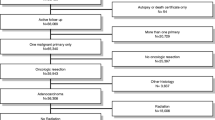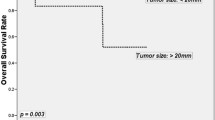Abstract
Background
Predicting rectal carcinoid behavior based exclusively on tumor size is imprecise. We sought to identify factors associated with outcome and incorporate them into a pre-operative risk stratification scheme.
Methods
Seventy rectal carcinoid patients evaluated at our institution were identified. Demographic, clinical, and histopathologic data were collected and correlated with recurrence and survival.
Results
The mean age of our cohort was 53.6 years. Fifty-seven percent of patients were female. The mean tumor size was 1.3 cm (range: 0.1–5 cm). Twenty-five percent of patients had deeply invasive tumors (into the muscularis propria or deeper); an equal percentage had tumors with lymphovascular invasion (LVI) or an elevated mitotic rate (≥2/50 HPF). Eleven patients (17%) had distant metastases at presentation. Sixty-one patients were followed for a median of 22 months (2–308 months), during which seven patients developed recurrence and seven died of disease (2/7 who developed recurrence). Poor outcome was associated with large tumor size, deep invasion, presence of LVI, and elevated mitotic rate. These factors were incorporated into a carcinoid of the rectum risk stratification (CaRRS) score. CaRRS predicted recurrence-free and disease-specific survival better than any single factor alone.
Conclusions
Poor prognostic features of rectal carcinoids include: large size, deep invasion, LVI, and elevated mitotic rate. The CaRRS score incorporates these features and accurately predicts outcome. Because the CaRRS score is based upon values available on pre-operative biopsy, it can identify patients with very favorable prognosis as well as those with poor prognosis that may benefit from additional staging or surveillance.



Similar content being viewed by others
References
Rorstad O. Prognostic indicators for carcinoid neuroendocrine tumors of the gastrointestinal tract. J Surg Oncol 2005; 89(3):151–60
Soga J. Carcinoids of the rectum: an evaluation of 1271 reported cases. Surg Today 1997; 27(2):112–9
Mani S, et al. Carcinoids of the rectum. J Am Coll Surg 1994; 179(2):231–48
Schindl M, et al. Stage-dependent therapy of rectal carcinoid tumors. World J Surg 1998; 22(6):628–33; discussion 634
Jetmore AB, et al. Rectal carcinoids: the most frequent carcinoid tumor. Dis Colon Rectum 1992; 35(8):717–25
Naunheim KS, et al. Rectal carcinoid tumors–treatment and prognosis. Surgery 1983; 94(4):670–6
Federspiel BH, et al. Rectal and colonic carcinoids. A clinicopathologic study of 84 cases. Cancer 1990; 65(1):135–40
Koura AN, et al. Carcinoid tumors of the rectum: effect of size, histopathology, and surgical treatment on metastasis free survival. Cancer 1997; 79(7):1294–8
Soga J. Early-stage carcinoids of the gastrointestinal tract: an analysis of 1914 reported cases. Cancer 2005; 103(8):1587–95
Shirouzu K, et al. Treatment of rectal carcinoid tumors. Am J Surg 1990; 160(3):262–5
Hochwald SN, et al. Prognostic factors in pancreatic endocrine neoplasms: an analysis of 136 cases with a proposal for low-grade and intermediate-grade groups. J Clin Oncol 2002; 20(11):2633–42
Travis WD, et al. Survival analysis of 200 pulmonary neuroendocrine tumors with clarification of criteria for atypical carcinoid and its separation from typical carcinoid. Am J Surg Pathol 1998; 22(8):934–44
Heah SM, et al. Tumor size is irrelevant in predicting malignant potential of carcinoid tumors of the rectum. Tech Coloproctol 2001; 5(2):73–7
Nikou GC, et al. Current diagnosis and treatment of gastrointestinal carcinoids in a series of 101 patients: the significance of serum chromogranin-A, somatostatin receptor scintigraphy and somatostatin analogues. Hepatogastroenterology 2005; 52(63):731–41
Author information
Authors and Affiliations
Corresponding author
Rights and permissions
About this article
Cite this article
Fahy, B.N., Tang, L.H., Klimstra, D. et al. Carcinoid of the Rectum Risk Stratification (CaRRs): A Strategy for Preoperative Outcome Assessment. Ann Surg Oncol 14, 1735–1743 (2007). https://doi.org/10.1245/s10434-006-9311-6
Received:
Accepted:
Published:
Issue Date:
DOI: https://doi.org/10.1245/s10434-006-9311-6




